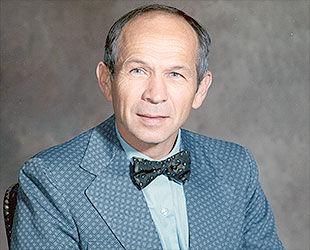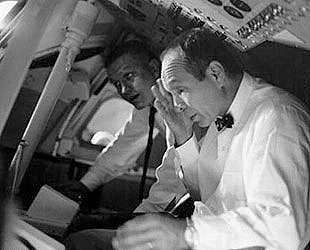 advertisements advertisements
|

|
Mercury capsule designer Max Faget dies

Maxime "Max" Faget, the designer of NASA's Mercury spacecraft and human spaceflight architect, died Oct. 9, 2004, at 93. (NASA) |
Oct. 10, 2004 — Max Faget, who in the late 1950s led the design of the United States' first manned spacecraft, died on Saturday at his home in Houston, Texas. He was 83.
As NASA's engineering and development director for the Manned Spacecraft Center (later Johnson Space Center) from 1962 through 1981, Max Faget designed the Mercury spacecraft and the Apollo command and service modules, as well as the space shuttle orbiter.
"Without Max's designs and approach to problem solving, America's space program would have had trouble getting off the ground," NASA Administrator Sean O'Keefe said in a statement. "He also was an aeronautics pioneer. In fact, it was his work on supersonic flight research that led to his interest in spaceflight."
Starting his career designing supersonic aircraft as part of the National Advisory Committee for Aeronautics (NACA) propulsion and performance team at Langley Aeronautical Laboratory, Faget contributed to the design of the X-15, an experimental rocket plane.
Drawing on aerodynamic principles established by Harvey Allen a decade earlier, Faget led the flight systems division that designed the Mercury spacecraft with a blunt-bodied capsule, enabling it to decelerate at higher altitudes in the atmosphere, reducing the amount of friction and heat upon re-entry.
Faget also designed the Mercury capsule with an escape tower that would allow the astronaut pilot to separate from the rocket in the event of catastrophic booster failure. This tower design ultimately saved two Russian cosmonauts in 1983.
Evolving the Mercury capsule's design, Faget collaborated with fellow NASA engineer Caldwell Johnson to design the Apollo spacecraft for lunar landing. He preferred to launch a capsule that could land on the Moon, but understood the drawbacks of launching the entire unit. He converted the Apollo spacecraft into two vehicles, command and service modules that would orbit the moon, and a separate lunar-landing craft.

Astronaut Frank Borman and Max Faget (foreground) inspect the interior of an Apollo command module mockup at Kennedy Space Center on April 9, 1967, as part of the NASA investigation into the fire that took the lives of the Apollo 1 crew. (NASA) |
Even as NASA was developing the Apollo spacecraft, the agency was setting its sights on a reusable space shuttle. Faget envisioned the orbiter with a straight-wing design. In the end, NASA opted for a delta-shape that differed from Faget's plan, but Faget was satisfied with the final result, remarking, "She really is a marvelous machine."
"Max Faget was truly a legend of the manned space flight program," stated Christopher Kraft, former Johnson Space Center director. "He was a true icon of the space program. There is no one in space flight history, in this or any other country, who has had a larger impact on man's quest [for] space exploration."
"He was a colleague and friend I regarded with the highest esteem," said Kraft. "History will remember him as one of the really great scientists of the 20th century."
Faget departed NASA in 1981 and two years later founded Space Industries to build an industrial space facility. Space Industries developed orbiting work platforms for launch on a shuttle mission. The platforms were designed to produce pharmaceuticals, electrical crystals, and metals that could not be made within the Earth's gravitational environment.
Graduating from Louisiana State University in 1943 with a bachelor of science, Faget was the recipient of honorary doctorates from University of Louisiana and the University of Pittsburgh.
He was also bestowed the NASA Medal for Outstanding Leadership, the Outstanding Accomplishment Award from the Institute of Electrical and Electronic Engineers (IEEE), and Gold Medal from the American Society of Mechanical Engineers.
In May 2003, Faget was inducted in the National Inventors Hall of Fame in Akron, Ohio. A statement announcing the honor included Faget's view on inventing.
"It's hard to tell people how you invent something. You see a problem, you solve a problem," said Faget.
"I enjoy solving problems," he added.
Faget was born on Aug. 26, 1921 in British Honduras to a noted tropical disease specialist, Guy Faget. As a child he read Astounding Science Fiction novels and built model kit airplanes, which he entered in competitions.
Faget is survived by four children, a daughter-in-law, two sons-in-law and 10 grandchildren. |

© collectSPACE. All rights reserved.

|
|

|

|
